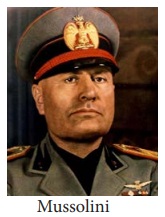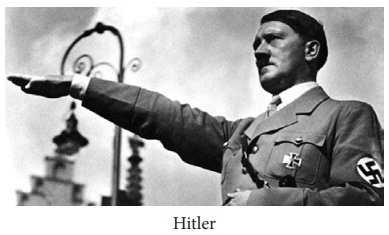World between Two World Wars | History - Rise of Fascism and Nazism | 10th Social Science : History : Chapter 2 : The World between Two World Wars
Chapter: 10th Social Science : History : Chapter 2 : The World between Two World Wars
Rise of Fascism and Nazism
Rise of Fascism and Nazism
(a) The Impact of War in Italy
The first
of the nations of Western Europe to turn against the old ruling regime was
Italy. During World War I the primary task of Italy was to keep the Austrians
occupied on the Southern Front, while the British, French and Americans
cornered Germany into submission along the battle lines in Flanders. The financial
cost of the participation in the War was huge. Moreover, after the War, in the
sharing of the spoils, Italy got less than she expected. The country suffered
heavy losses in a war that was unpopular with both socialists and pro-Austrian
Catholics. The nationalists were equally unhappy with the marginal gain in
territory from the Treaty of Versailles. The War resulted in inflation. There
were frequent protests and strikes. People held the rulers responsible for the
humiliation at Versailles.
Emergence of Mussolini
In the
elections held November 1919 in the aftermath of the Treaty of Versailles,
Italian socialists, proclaiming that they were following Bolshevism (Communism
in Soviet Russia), won about a third of the seats. Mussolini, son of a
blacksmith and qualified as an elementary school master, in the end became a
journalist with socialist views. A forceful speaker, Mussolini began to support
the use of violence and broke with the socialists when they opposed Italy’s
entry into the War. When the Fascist Party was founded in 1919 Mussolini
immediately joined it. As Fascists stood for authority, strength and
discipline, support came from industrialists, nationalists, ex-soldiers, the
middle classes and discontented youth. The Fascists resorted to violence
freely. In October 1922, in the context of a long ministerial crisis, Mussolini
organised the Fascist March on Rome. Impressed by the show of force, the King
invited Mussolini to form a government. The inability of the Democratic Party
leaders to combine and act with resolution facilitated Mussolini’s triumph.
Fascism is a form of radical authoritarian ultra-nationalism, characterised by dictatorial power, forcible
suppression of opposition and strong regimentation of society and of the
economy, which came to prominence in early 20th-century Europe. –Wikipedia.
Fascists under Mussolini
In
the 1924 elections, after intimidation of the electors, 65 per cent of the
votes were cast for the Fascists. Matteotti, a socialist leader, who questioned
the fairness of the elections was murdered. The opposition parties
boycotted the Parliament in protest. Mussolini reacted by banning opposition
parties and censoring the press. Opposition leaders were killed or imprisoned.
Assuming the title of Il Duce (the leader), in 1926 he became a dictator with
power to legislate. He passed a law forbidding strikes and lockouts. Unions and
employers were organized into corporations. In 1938 Parliament was abolished
and was replaced by a body representing the Fascist Party and the corporations.
This new arrangement bolstered Mussolini’s dictatorial control of the economy,
as well as enabling him to wield enormous power as head of the administration
and the armed forces.

Mussolini’s Pact with Pope
In order
to give respectability to the Fascist Party, Mussolini won over the Roman
Catholic Church by recognising the Vatican City as an independent state. In
return the Church recognised the Kingdom of Italy. The Roman Catholic faith was
made the religion of Italy and compulsory religious teaching in school was
ordered. T e Lateran Treaty incorporating the said provisions was signed in
1929.
Italy during the Great Depression
During
the years of the Great Depression the much publicised public works of building
new bridges, roads and canals, hospitals and schools did not provide solution
to the unemployment problem. In 1935, Mussolini invaded Ethiopia. This was
useful to divert attention of the people away from the economic troubles.
(b) Germany in the post-War
From 1918
to 1993 Germany was a republic. The factors which led to the eventual triumph
of Fascism in Germany were many. Between 1871 and 1914 Germany had risen to
dizzy heights of economic, political and cultural accomplishments. Germany’s
universities, its science, philosophy and music were known all over the world.
Germany had surpassed even Britain and the US in several fields of industrial
production.
Germany’s defeat and humiliation at the end of World War I caused a deep shock to the of German people. The Great Depression further deepened their frustration and prompted them to turn against the Republican government.
Evolution of German Fascism
The
origin of German fascism goes back to 1919 when a group of seven men met in
Munich and founded the National Socialist German Workers’ Party (abbreviated as
Nazi Party). One of them was Adolf Hitler. During World War I, he served in the
Bavarian army. A gifted speaker, he could whip up the passion of the audience.
In 1923 Hitler attempted to capture power in Bavaria. His launch of the
National Revolution on the outskirts of Munich landed him in prison. During his
time in prison wrote Mein Kampf (My
Struggle), an autobiographical book containing his political ideas. In the
Presidential election of 1932, the Communist Party polled about 6,000,000
votes. Alarmed capitalists and property owners tilted towards supporting
fascism Hitler exploited this opportunity to usurp powers.

Social Democratic Party was founded as the General German
Workers Association on 23 May 1863 in Leipzig. Founder was Ferdinand Lassalle.
German elites of the late 19th century considered the very existence of a
socialist party a threat to the security and stability of the newly unified
Reich, and so Bismark outlawed this party from 1878 to 1890.
However, in 1945, with the fall of Hitler, the Social Democratic
Party was revived. It was the only surviving party from the Weimar period with
a record of opposition to Hitler.
The Nazi State of Hitler
Republican
government fell, as the Communists refused to collaborate with the Social
Democrats. Thereupon industrialists, bankers and Junkers prevailed upon
President Von Hindenburg to designate Hitler as Chancellor in 1933. The Nazi
state of Hitler, known as Third Reich, brought an end to the parliamentary
democracy.
Hitler
replaced the flag of the Weimar republic by the swastika banners (![]() )
of
National Socialism. Germany was converted into a highly centralised state. All
political parties except the Nazi party were declared illegal. The army of
brown-shirted and jack-booted storm-troopers was expanded. The Hitler Youth was
created, and the Labour Front set up. Trade unions were abolished, their
leaders arrested. Strikes were made illegal, wages were fixed by the
government. Total state control was extended over the press, the theatre, the
cinema, radio and over education.
)
of
National Socialism. Germany was converted into a highly centralised state. All
political parties except the Nazi party were declared illegal. The army of
brown-shirted and jack-booted storm-troopers was expanded. The Hitler Youth was
created, and the Labour Front set up. Trade unions were abolished, their
leaders arrested. Strikes were made illegal, wages were fixed by the
government. Total state control was extended over the press, the theatre, the
cinema, radio and over education.
T e Nazi
Party’s propaganda was led by Josef Goebbels, who manipulated public opinion
through planned propaganda. The Gestapo or Secret State Police was formed and
run by Himmler.
Nazi Policy towards Jews
Along
with the repressive measures, Hitler’s government followed a policy of
repressing Jewish people. The Jews were removed from government positions,
excluded from the universities and deprived of citizenship. Jewish businesses
were closed down, and their establishments were attacked. After the outbreak of
World War II concentration camps, barracks surrounded by electrified fences and
watch towers, were built where Jews were interred and used as forced labour. Later
they were turned into extermination camps where industrial means of murder such
as gas chambers were used to kill them in what the Nazis termed ‘The Final
Solution’.
Defiance of the Treaty of Versailles
In August
1934 Hindenburg died and Hitler, apart from being Chancellor, became both
President and Commander–in-Chief of the armed forces. Hitler’s foreign policy
aimed at restoring the armed strength of Germany and annulling provisions of
Versailles Treaty.
Related Topics